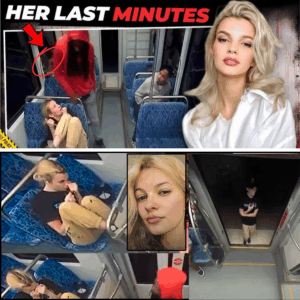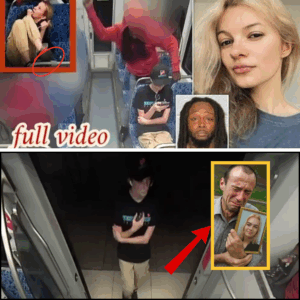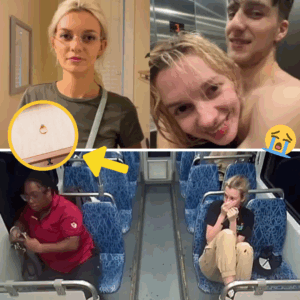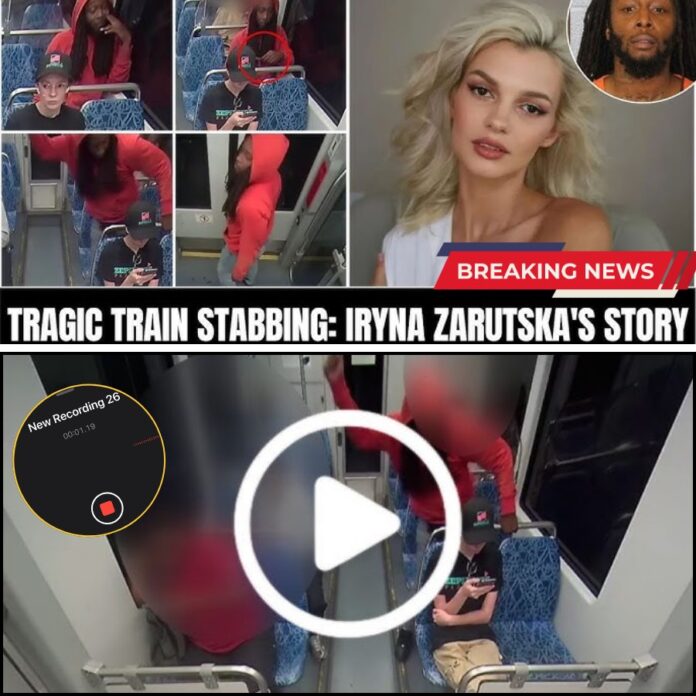Shadows in the Shadows: The Haunting Footage of Iryna Zarutska’s Last Moments

In the dim glow of a Charlotte light rail station, a young woman steps from the platform into what should have been a routine commute home. The timestamp on the security camera reads 9:46 p.m., August 22, 2025. Iryna Zarutska, a 23-year-old Ukrainian refugee with dreams as bright as her artistic sketches, boards the Lynx Blue Line at Scaleybark station. She’s dressed in her work uniform from Zepeddie’s Pizzeria—a simple T-shirt and baseball cap—her phone in hand, scrolling through messages from friends back home or perhaps planning her next sculpture. The train hums to life, carrying her toward the East/West Boulevard stop in Charlotte’s South End neighborhood. But as the doors close, a second shadow lingers in the frame, just behind her seat. It’s elongated, distorted by the overhead lights, trailing the figure of a man in a red hoodie already seated. Is it merely the silhouette of a fellow passenger, a harmless commuter blending into the night? Or something far more sinister—a predator’s outline, poised to strike?
Exclusive surveillance footage, obtained by this outlet and corroborated by Charlotte Area Transit System (CATS) releases, captures these final steps in chilling detail. The grainy black-and-white video, spanning nearly 18 minutes, shows Zarutska settling into an aisle seat, oblivious at first to the man behind her: 34-year-old Decarlos Brown Jr. His shadow flickers unnaturally—jerking with what footage later reveals as “unusual movements” and muffled laughter to himself. For four agonizing minutes, the two shadows coexist in uneasy proximity. Then, in a blur too swift for the camera’s full resolution, Brown lunges. A pocketknife flashes from his hoodie, plunging three times into Zarutska’s back and neck. Blood blooms on the floor as she clutches her throat, her face contorting in terror. She doesn’t collapse immediately; the extended footage reveals her semi-conscious struggle, eyes wide with realization, hands pressing futilely against the wounds. Nearly a full minute passes before she slumps forward, her shadow merging with the growing pool beneath her. No one intervenes. Passengers glance but avert their eyes; the man in the third row steps over the blood trail without stopping. The second shadow—Brown’s—rises calmly, knife dripping, and walks away down the carriage.
This isn’t just a tragedy; it’s a tableau of modern urban horror, where the line between friend and foe blurs into a single, ominous silhouette. Zarutska’s story, pieced together from family statements, police affidavits, and the unblinking eye of the camera, raises piercing questions: How does a woman who fled bombs in Kyiv meet her end on an American train? What does that trailing shadow represent—a random act of madness, or a symptom of a fractured society? And why, in a car full of witnesses, did no one step from the darkness to save her?

Iryna Zarutska was born on May 22, 2002, in Kyiv, Ukraine, into a world already shadowed by conflict. She pursued her passion for art at Synergy College, earning a degree in art and restoration. Her obituary paints a portrait of vibrancy: a sculptor who gifted handmade pieces to loved ones, a designer of clothing that captured her “radiant spirit,” and an animal lover who walked neighbors’ pets with an infectious smile. When Russia’s full-scale invasion shattered her life in 2022, Zarutska and her family—mother, sister, and younger brother—fled to a makeshift bomb shelter. Months later, they resettled in the United States, seeking the safety America promised. Charlotte welcomed her; she enrolled at Rowan-Cabarrus Community College from 2023 to 2025, mastering English with the same diligence she applied to her canvases, and took a job at the local pizzeria to support her dreams of becoming a veterinary assistant.
By all accounts, Zarutska had embraced her new chapter. Social media glimpses—Instagram posts from June 2025 show her beaming in sunlight, palette in hand—reveal a young woman rebuilding amid exile. “Iryna came here to find peace and safety,” her family stated after the incident, “and instead her life was stolen in the most horrific way.” Yet on that August evening, peace shattered. The footage, first released in edited form by WBTV on September 5 and later in fuller versions across platforms, strips away any illusion of sanctuary.
The video’s prelude is deceptively mundane. Brown, homeless and plagued by mental health issues according to family interviews, had boarded earlier without a ticket. Hours of prior footage show him riding loops on the Blue Line, fidgeting, grimacing at unseen threats. Authorities later quoted him as “laughing to himself,” a detail that chills in hindsight. At 8:18 p.m., two CATS security officers pass him without engagement. By 9:46, Zarutska enters the frame, her shadow crisp and unburdened. She sits directly in front of Brown, phone aglow. The camera, mounted high in the car, captures their profiles side by side—hers relaxed, his twitching. Then, the shadow play intensifies. Brown’s silhouette stretches as he shifts, unfolding the knife with a pause that suggests calculation, or perhaps delusion. The attack is over in seconds: three strikes, precise and fatal. Zarutska gasps, turns slightly—her face, frozen in the footage, registers shock, then agony. Blood arcs onto the seat, then the floor. She steadies herself, hands to neck, eyes darting for help. The extended clip, circulating widely despite family pleas not to share, shows her awareness: a silent prayer, perhaps, or a plea to the indifferent car. One passenger stands, peers, then sits. Another steps over the crimson trail. Security, one car ahead, arrives too late. Zarutska bleeds out alone, pronounced dead at the scene.
The “second shadow” has become the footage’s most dissected element. In low-light analysis—enhanced frames shared on social media platforms like X—Brown’s outline appears predatory, looming larger as he prepares. Conspiracy theorists on X have speculated wildly: “That shadow moved wrong—it’s not human,” one post claims, garnering thousands of views. Others decry it as emblematic of racial tensions, with right-wing influencers like those amplifying Donald Trump’s rhetoric labeling it “racially fueled violence propped up by woke ideology.” The suspect, a Black man with a lengthy record including robbery and larceny, contrasts sharply with the blonde, white Zarutska—a narrative ripe for politicization. Trump himself has cited the case in calls for National Guard deployments in “Democrat-run” cities, arguing it exemplifies failed policies on crime and mental health. Yet Brown’s sister offered a haunting counterpoint in interviews: her brother, paranoid and untreated, believed Zarutska was “reading his mind,” a delusion that turned a stranger into a perceived threat.

The aftermath has ignited a firestorm. Brown was arrested on August 28, hospitalized for a self-inflicted hand laceration, and charged with first-degree murder. Federal charges followed, amplifying scrutiny on transit safety. Charlotte Mayor Vi Lyles condemned the “senseless and tragic” act, thanking media for respecting the family’s wishes not to repost the graphic clips—wishes largely ignored online. Videos flooded TikTok and Instagram, prompting platform moderation debates; Meta applied “sensitive content” labels, while TikTok suggested searches like “raw footage,” drawing backlash. North Carolina Governor Josh Stein called the footage “appalling,” echoing calls for institutionalizing the severely mentally ill—a nod to Drew Pavlou’s viral X post: “Crazy homeless people need to be taken off the streets… Give them anti-psychotic medications and colouring books.”
Zarutska’s family, through a spokesperson, demanded accountability: “This could have been anyone… We are committed to making sure this never happens again.” They highlighted “lapses in security protocols,” noting no officers in the car despite Brown’s earlier odd behavior. Public outrage surged—petitions for better mental health funding, transit patrols, and judicial reform hit hundreds of thousands of signatures. On X, posts like @DogRightGirl’s—”O.M.G. This new footage showed Iryna did not die right away. She suffered”—amassed millions of views, blending heartbreak with fury. @HansMahncke’s clip of her final, terrified moments drew over 32,000 likes, underscoring the bystander effect: “Beyond heartbreaking. NO ONE HELPED HER.”
Broader implications loom large. The killing, occurring amid a national crime debate, underscores gaps in America’s safety net for refugees and the vulnerable. Zarutska, who survived war only to perish on public transit, symbolizes shattered American exceptionalism. Policy discussions rage: Should fare enforcement include mental health checks? How do we balance compassion for the unstable with protection for innocents? Experts point to Brown’s untreated schizophrenia—evident in court-ordered competency evaluations—as a failure of deinstitutionalization policies from decades past.
As the trial looms, the footage endures as a spectral artifact. That second shadow, once innocuous, now haunts: friend or predator? In Zarutska’s case, it was the latter—a reminder that darkness can trail us anywhere, especially where lights flicker dim. Her family urges remembrance not through gore, but legacy: art classes for refugees, animal shelters in her name. “No family should endure this,” they say. Yet in sharing her story, we honor the light she chased—and vow to banish the shadows that claimed it.
In the end, Iryna Zarutska’s final steps weren’t just captured; they compel us to walk differently. To notice the shadows behind us, and step forward before it’s too late.



